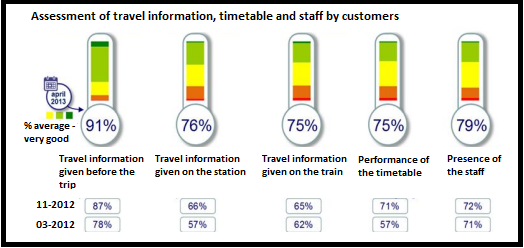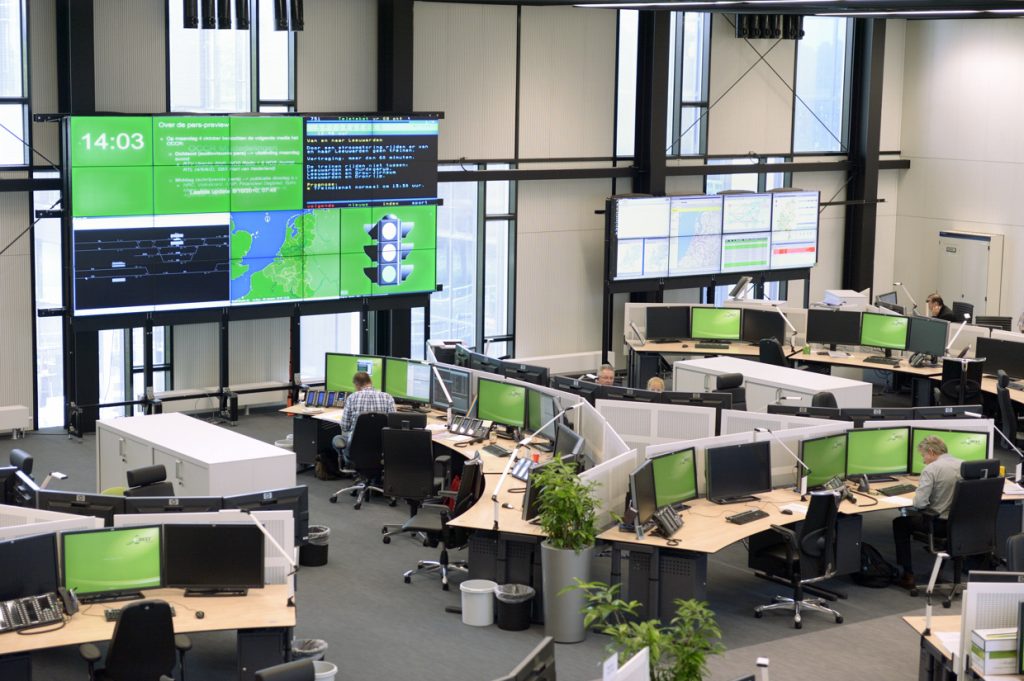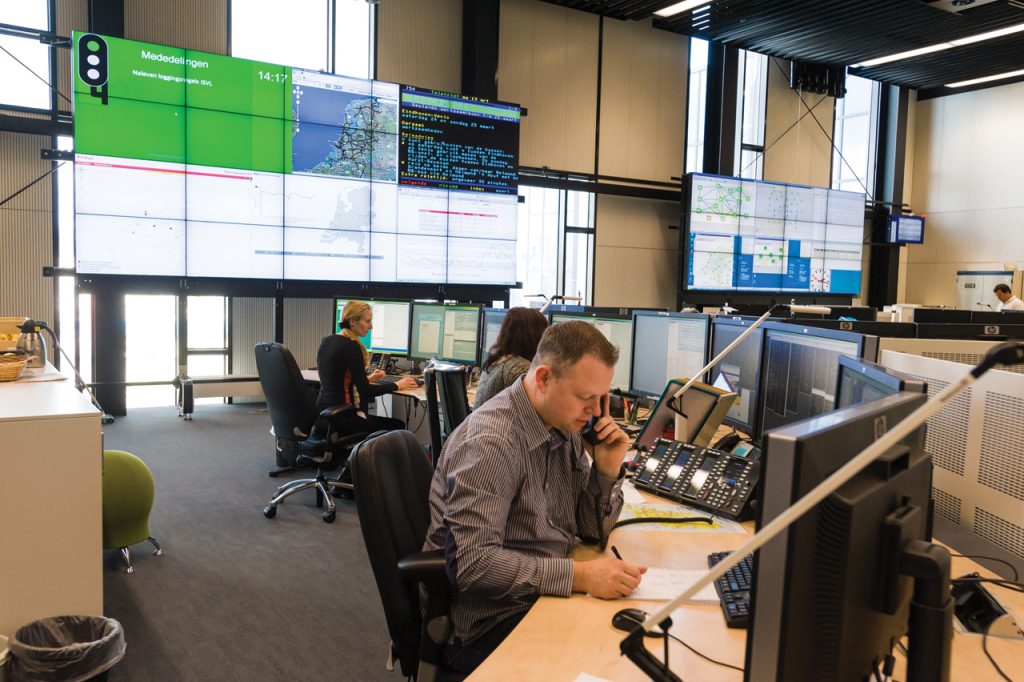4.3.1 to 4.3.4
Course subject(s)
4. Complexity of Disruptions
Effects
4.3.1 Financial Losses
Disruptive events can have many different effects on the increasingly complex railway systems. A train delay, train failure, station closure or communication issues can cause delays in the service on a first level: passengers miss trains, take detours, and there is a reduction of the customer satisfaction. These disruptions can also extend to different lines and stations and/or pose a threat to passengers.
In this section, we first will look at some financial, technical and operational effects, before we look more closely at the passengers in play. The third part gives an overview of all disturbances occurring over a full year focussing on both origin and effects.
Financial losses
The response of the passengers to the disruptions has a direct effect on the revenue of the railway operator company for that day. The revenue loss during a disruption comes from passengers leaving the system, not entering the system (knowing of the disruption) or changing their path (or destination) inside the system, depending on the method used for pricing.
Next to the losses mentioned above, the railway operator suffers additional losses due to the resources needed to resolve the disturbance. Also, for example in case of an accident, equipment and track might need to be replaced and there might even be lawsuits following, which will cost the operator a lot of money.
Closing down a bridge can cost a million euros per day. This could come from technical or operational issues, delayed construction work or safety measures set by emergency services. In any case, there is big loss in not being able to use the infrastructure, which results in cancelling trains or long detours.
Where a single switch failure can already result in a full bridge being out of service, most problems occur as a follow-up disruption. Everything on the bridge is connected with wires and precise technical connections. Digging up or repairing something often results in another problem, which might even be bigger. This problem is worsened by the fact that different sections (with its own people) work on different aspects of the railway network, without knowing what they might break or interfere with when solving the issue within their own field. This increases the complexity and can create effect after effect, resulting in more costs and a bridge that cannot be opened at the scheduled time.
Apart from the measurable costs in the moment, disruptions can also be harmful to the image of the railway network. Most of the time that rail-related issues are in the news, the coverage is negative. Since trains are a social issue, people have strong opinions about it and expect it to be working according to high standards. Communication to travellers can play an important part in limiting this effect, but often these channels are used too late, which aggravates the problem.
Other expensive issues are the cancelation of international and/or freight trains. As mentioned in the previous section, each freight train (or wagon for that matter) is commercially based and cancelling could have large consequences in getting the load to the right location, where than trucks will be waiting for a train that does not or will arrive late and shops have empty shelves.
In the following sections, we will look at solving and prevention and, in the upcoming week, we will go into even more detail about monitoring and maintenance. Knowing what happens, predicting it and even preventing things from happening can save on operational and technical costs, as well as income and image.
4.3.2 Effects on Passengers
The first, most evident effect of railway disruptions on passengers is a decreased level of satisfaction. The effect of a disruption to each particular passenger is dependent on many factors, including: their own personal characteristics (e.g. personality traits and health), personal timetable, the type of situation and how serious it is, the presence of risks to them, how well they are informed about the situation, the temperature, the amount of passengers affected and how far they are from their final destination.
As an example, in case of a delayed train, passengers could become impatient, irritated and confused. But this will have more effects on a passenger hoping to catch their flight than a passenger that doesn’t mind being home 10 minutes later.
During a disruption in the railway system, passengers may try to reach their destination by other means. Again, this depends very significantly on passengers’ personal characteristics and needs. Additionally, the choice of changing the path of travel during a disruption depends on the robustness of the rail network. That is: how many different paths within the network the passenger can take to reach the desired destination.
That being said, during a disruption (such as delayed or stopped trains and blockages or other timetable disrupting events), passengers can respond with three different options:
- Leave the railway system
- Change path within the system (with/without changing their destination)
- Wait (be delayed) and continue the original path
Moreover, passengers changing their path within the system can cause the disruption to extend to additional lines by overloading them. But passengers waiting to continue the original path can cause also a second, follow-up disruption (overcrowding) on the affected line, once the original situation is resolved, because of the accumulation of waiting passengers.
It is important to know what users (travellers) think of the service and network. The Dutch Railways conduct surveys to anticipate on the passengers experience. This ranges from available travel information to the presence of staff. By analysing this data improvements can be made.

The above image shows the results of three surveys held in march 2012, november 2012 and april 2013, being on the begin and end of the winter season which has the most malfunctions and changes in the timetable. Passengers could rate several topics between ‘very bad’, ‘bad’, ‘average’, ‘good’ and ‘very good’. The percentages given is the summation of the ‘average’, ‘good’ and ‘very good’ assessments. It can be seen that customer satisfaction has improved. Passengers were most positive about the fact that there’s a lot of information available before the trip, so they can plan ahead and know what to expect.
In the next item we will look in more detail to winter operations and the effects on passengers.
Facts and figure based on a report by NS and ProRail
4.3.3 Winter Operations
A delayed or even skipped train can be a common result of unexpected weather conditions, like heavy snowfall, low temperatures, glazed frost etc. The real cause can be either found in infrastructure or rolling stock, but the effects are often still similar. A precautionary reduction of the number of trains by the train operator can be a solution based on expected weather conditions.
Effects
When trains get delayed due to heavy winter conditions, it is much likely that it is not only one train that is affected. A couple of delayed or even stranded trains in the same area can cause a disastrous effect on the overall train service. Skipping trains is sometimes the only way to create a workable schedule. From a passengers point of view a skipped train means delay, waiting on a crowded platform for the next train that very likely will already be overcrowded, not rarely missing connections at your next station. In general, passengers accept discomfort due to heavy snowfall, since it is a visible condition and not only train service has to deal with it but also road and air traffic are affected.
Where people will understand that extreme frost will affect train services, they expect problems to be solved after a couple of days. As soon as the roads are accessible, why are trains still delayed? From an operators point of view a skipped train will still be an obstacle: it can be wiped from the timetable but physically it is still standing somewhere at the wrong place, blocking a (side) track. That specific train and its crew is supposed to be somewhere else. This effect is not always taken into account, but can be rather disastrous and might affects timetabling the next day.
Keeping in mind the effects mentioned above, train operators still choose to reduce train service in advantage. With less trains running, the trains can get overfilled with passengers, but notifications the prior day create awareness of the problem and gives people to possibility to plan their journey differently.
The idea behind the preventive reduction of trains is that less trains on the network will make the train service less sensitive for disruptions. Of course the disadvantage is that the capacity also reduces: not everyone will find a seat or cannot even get in. With less trains on the network also connecting links to other means of transport can be lost, which increases the total door-door travel time.
Passengers seem to accept the precautionary reduction of trains rather well. They are more accommodating as they have some control over planning their journey (finding alternative routes on forehand). However, the acceptance decreases after a couple of days and especially if the conditions are not longer visible: snow is accepted, low temperatures not. Sometimes passengers complain about the capacity of the trains: why don’t they extend the trains to maximum length? A rather understandable question. But for the operator this can be a logistic problem. Extending trains means that extra coaches and units must be available on the right spot at the right time and possibly will end up at the other side of the country. Sometimes it is simply not possible to get all rolling stock within one night at the desired location to be ready for rush hour the next day.
Resolve and Prevent
Where the next sections will be more dedicated to resolving and prevention, we will already have a look at some solutions.
How to get thousands of passengers to their destination if railway lines are unusable? The only alternative is alternative ways of transportation. Keeping in mind that the capacity of a single bus is less than half a passenger coach you need a lot of buses! All need to be available on demand, including drivers, in the direct vicinity of the station in question. Where this is an extreme challenge to organise, train travellers will most likely not appreciate the delay and don’t know what is happening in the mean tim to minimise the problem for everyone.
In 2012 Dutch Railways introduced a protocol for winter conditions. The main goal is to avoid those out of control situations. If according to weather forecast the probability is more than 10% that there will be snowfall of more than 3 cm and/or the probability that temperature will drop below -10 degrees for the next day, a reduced timetable can be introduced for that day. In clear language this means that trains will be skipped on in beforehand; for example a 30 minutes service can be reduced to a 1 hr service. But the final decision must be carefully taken, since it means that twice as many people (or close to that number) have to travel with less capacity. In the winter of 2012/2013 in total 27 days complied with the above weather conditions. For only 12 days the precautionary reduced train service was actually performed for the whole network and for 2 more days it was performed only locally.
A reduced service is not a perfect solution, but it can help to limit the effects. Train operators will always keep working on a more reliable train service under bad winter conditions. Sometimes it can help if (empty) trains keep on running during the night, preventing catenary systems from being affected by glazed frost. To keep passengers satisfied it is important to inform well and on time like mentioned in the previous section.
Facts based on a report by NS and ProRail
4.3.4 Daily Incident Report
Earlier, we looked at the yearly report of all disruptions within the Netherlands. This information is based on very detailed documentation of all specific incidents that happen any day of the week, month and year. Where the railway network itself is divided in regional parts, in the Netherlands, there is one main central control centre, where everything comes together.
This nerve centre OCCR (Operation Control Centre Rail) lies in Utrecht (centrally located in the country), where all stakeholders involved in the railway network have representation within the same room. This enables fast communication and solutions, if something happens anywhere on the track. In this week’s ‘Ask the Professor’, Rolf Dollevoet will explain more about the OCCR from inside of the building.


Images by OCCR (left) and ProRail (right)
All information on each incident, delay or issue on any train or part of the infrastructure within the Netherlands will be analysed and handled in this room. Everything is documented and solved on the spot with all necessary parties present. Where most are small, and thus only have small effects on the full schedule, some can be very large and complicated. A daily overview is made for documentation, longterm reports (like the year report 2017 discussed earlier) and to learn and prepare for future situations.
This daily report is based on five main factors:
- Overall passengers that day
- Main national network/connections
- Regional networks
- High speed network
- Freight network
All are very detailed analyses and are categorised as: regular day, busy day or extreme busy day. High speed and freight almost always are extremely busy. All others are usually classified as regular.

Railway Engineering: An Integral Approach by TU Delft OpenCourseWare is licensed under a Creative Commons Attribution-NonCommercial-ShareAlike 4.0 International License.
Based on a work at https://ocw.tudelft.nl/courses/railway-engineering-integral-approach/.




